Yamaha has changed the face of dirt bike history numerous times over the last 40 years. Here’s a look back at the highlights of Yamaha Dirt Bike History.
From the first ‘monoshock’ motocrossers of the seventies to leading the four-stroke motocross revolution in 1997, Yamaha dirt bikes have constantly been at the leading edge of innovation.
The Early Years
Yamaha was founded in 1887 by Torakusu Yamaha as a piano and Reed Organ Manufacturer. The company’s musical instrument heritage is still reflected today with the logo of three interlocking tuning forks. The three tuning forks represent the three pillars of business – technology, production, and sales.
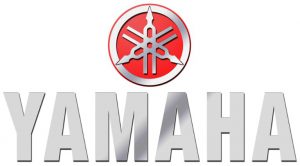
After World War 2 company president Genichi Kawakami repurposed the production machinery for the manufacture of motorcycles.
In 1954 the first production motorcycle, the YA-1 was launched. 125 were built. It was a 125cc single-cylinder two-stroke, patterned on the German DKW RT125.
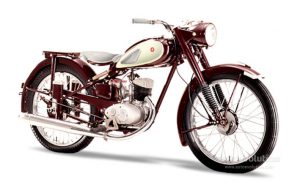
The success of the YA-1 led to the founding of Yamaha Motor Co. Ltd in 1955.
In 1968 Yamaha’s first dirt bike was produced, the DT-1, a two-stroke 250cc trail bike. It was hugely successful.
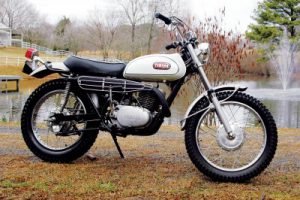
1975 was the year Yamaha released the first production model motocross bike with the ‘monoshock’ single rear suspension setup.
In 1976 Yamaha produced another first, the introduction of the air forks with the YZ125X. It was not hugely successful, and by the following year returned to conventional forks.
The late seventies also saw the introduction of the first Japanese two-stroke enduro bikes, the IT series, which led the swing away from the more expensive European competition enduro bikes.
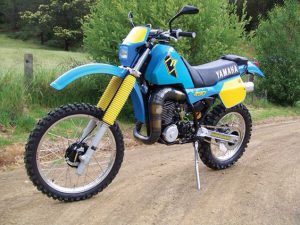
The first big-bore four-stroke trail bikes were also appearing with the Yamaha TT and XT500 thumpers.
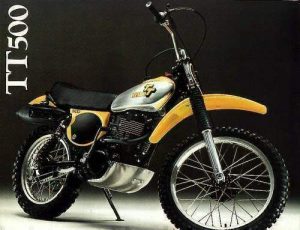
Heavily modified versions were having competition success, like the HL500. A prototype built by Swedish MX world champions Torsten Hallman and Sten Lundin was made famous by Bengt Aberg in the 1977 Swedish 500cc GP series.
His success lead to Yamaha producing a limited run of production HL500s, which boosted sales of the TT/XT500 trail bikes.
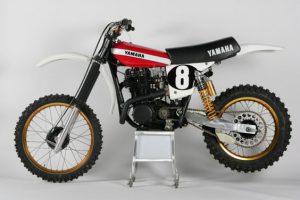
In 1981 Yamaha released the first water-cooled motocross bike to the mass market with the YZ125H and YZ250H.
In 1996 the AMA changed the rules of Motocross racing to allow a 450cc four-stroke machine to compete in the same class as the 250cc two-stroke. This changed things forever in the MX scene and led to the first victory of a four-stroke bike in an AMA Supercross event in Las Vegas in 1997 by Doug Henry on a Yamaha YZM400F.
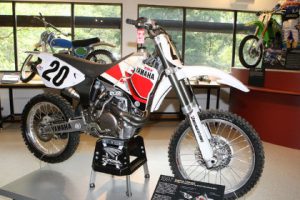
In 1998 Yamaha released the YZ400F to the public. It was the first mass-produced four-stroke motocross bike.
Yamaha is one of the ‘Big Four’ Japanese manufacturers alongside Suzuki, Honda, and Kawasaki, and has always been an innovator. They have changed the color of their dirt bikes numerous times – yellow/Black, white, and Blue.
When you compare today’s enduro and motocross bikes to the first DT1 trail bikes of 1968, the advancement in technology is incredible. The tuning fork company has come a long way.
Yamaha Racing Legends
Kenny Roberts
“King” Kenny Roberts was born in Modesto, California on December 31, 1951. He was the first American to win a Grand Prix motorcycle world championship in 1978. He was also twice the winner of the AMA Grand National Championship.
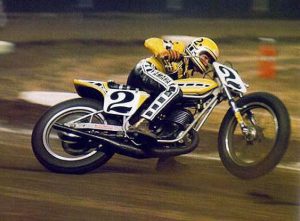
Roberts has also won the AMA Grand Slam, having Grand National wins in the mile, half-mile, short-track, TT Steeplechase and road race events, one of only four riders in AMA history to do so.
In 1990 he was inducted into the Motorsports Hall of Fame of America.
In 1992 he was inducted into the International Motorsports Hall of Fame.
In 1998 he was inducted into the AMA Motorcycle Hall of Fame.
In 2000 the FIM named him Grand Prix “Legend”.
Career Highlights
In his 13-year professional racing career, Roberts won:
- Two Grand National Championships
- Three 500cc World Championships
- 32 Grand National wins
- 24 Grand Prix road race wins
- Three-time winner of Daytona 200
- Three-time winner of Imola 200
- Six-time winner of the Laguna Seca 200
Bob Hannah
Bob “Hurricane” Hannah was born in Lancaster, California on September 26, 1956. He is one of the most successful motocross racers in American history, having won a total of seven AMA National championships. He won a record eight consecutive 250cc outdoor national titles.
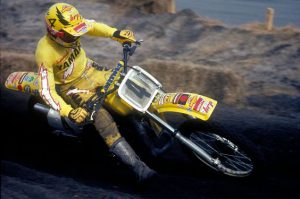
In his 15 year career, he had become the all-time win leader in AMA motocross/supercross history, winning 70 national titles during his career. Jeremy McGrath would break that record in 1999.
In 1999 he was inducted into the AMA Motorcycle Hall of Fame.
In 2000 he was inducted into the Motorsports Hall of Fame of America.
Since retiring from his motocross career he competed in the sport of airplane racing and has been running a sport aviation sales company, and a winery.
Career Highlights
- 1976 125cc National Champion
- 1977 250cc Supercross Champion
- 1978 250cc Supercross Champion
- 1978 250cc National Champion
- 1978 Trans-AMA Champion
- 1979 250cc Supercross Champion
- 1979 250cc National Champion
- 1987 Motocross des Nations Champion
Stephen Gall
Stephen Gall is a true legend of Australian motocross, and since bursting onto the Australian motocross scene in the 70s has always remained loyal to Yamaha. He set new standards in professionalism, fitness, skill, and versatility.
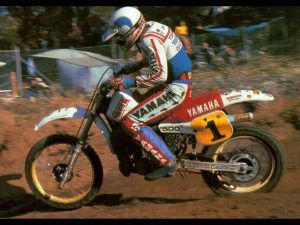
Back in the late 1970s, the glory days of Australian motocross, Stephen Gall and Anthony Gunter had a stranglehold on the Mister Motocross series. It was Suzuki vs Yamaha – Gunter vs Gall.
The Mister Motocross series ran from 1974 to 1990 and was the pinnacle of Australian Motocross at the time. Stephen Gall emerged as the winner in 1978, 1980, 1981 & 1982.
In 2016 he was inducted into the Australian Motor Sport Hall of Fame.
In 1978 he founded the Academy of Off Road Riding, helping train up-and-coming riders.
In 1988 Stephen founded Gall Bros. Medical, which markets CTI knee and wrist braces used by many top riders, but also used for a wide range of sports and activities.
Stephen was in charge of the motorcycle stunts in the 2015 movie ‘Mad Max Fury Road’ and at age 59 was one of the stunt riders too!
Career Highlights
- Four times Mister Motocross Champion
- Five times Australian Motocross Champion
- Three times Australian Dirt Bike Champion
- Two times winner Finke Desert Race
- Winner of 30 state Motocross championships
- One-time winner UK Supercross Masters
- Australian Speedway Speedcar Champion
- Australian Dual Slalom Mountain Bike Champion
When you look back over the last 40 years of Yamaha dirt bike history, it’s easy to see why Yamaha has become one of the world’s leading manufacturers. I can’t wait to see what the future holds.
Related Posts
Do you have a favorite Yamaha? Have you have owned one of the legendary Yamaha models mentioned in this post, please feel free to share your story in the comments below.

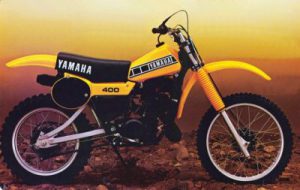
The evolution of the yamaha dirt bike is awesome.I have a yamaha DT125 bike.Model year is 2001.Fuel consumption is very good.It has a powerful engine which can go on any mountain. So I know yamaha bikes are better than others.your presentation is very good and useful for bike riders.Thank you.
Hi Kasun, thanks for your comments. The DT125 is a great bike. The Yamahas are so reliable and the DT series as you know is the bike that started the whole dirt bike movement, the very first DT1 released in 1968. I remember one of my friends buying one. Glad you enjoyed the post.
Greg
I find it a little dissappointing that Kawasaki was left completely off the list. They made far more bikes than KTM or Husquavarna.
You’re absolutely right, Kawasaki is the only one of the big four Japanese bikes that I have yet to write a history on. Kawasaki Dirt Bike History will be the next one.
Update: Ask and you shall receive. Here is my new post: Kawasaki Dirt Bike History
I am after a YZ 360 from the 70’s, the model had straps over the tank. This bike will have to be in original condition & have matching numbers ???
Hi Stephen. I remember that model well, I nearly bought one back in the seventies. I hope you can find a good one in mint condition. Maybe contact some VMX clubs, they may know someone who has one for sale.
Thanks for your thoughts. Good luck with your search.
Really cool does anyone know where to find parts for 1979 yz 100 need pipe seat about it thanks love the old bikes simple and fast
Hi Daniel. Not sure what country you are in so can’t advise, but my first place to look would be to google search Vintage Motocross clubs in your area. There are bound to be parts still around if you search online.
You’re right, the old bikes are so simple, they were easy to work on, most riders did all their own maintenance back then. Thanks for your thoughts.
Greg
We have a 80 cc dt or gt that we bought from a neighbour. The number stamped on the engine is 2G9- then 6 digits. I can’t find any info on this bike. I’m thinking it is 1978 to 1980. It is in mint original condition and I was wondering what it should sell for if we decided to sell it. The tank has a red stripe with two thin black stripes below it.
Hi Terry. I googled 1980 Yamaha DT80 and found one that matched your description of a red stripe with two black stripes below it. Its value would depend on what country you’re in, but the one I found that sold in Las Vegas got a price of $1,250 back in 2017. Does this one look like yours? Here is the link: 1980 Yamaha DT80
Hope this helps.
I am trying to identify the year and model of a Yamaha off-road bike that appears to be from the late 70’s and I was told it was a 400 or in that class and the original owner is deceased so I cannot ask anyone for additional information. The VIN is nine digits and does not show up anywhere. It has a headlight, tail light and a speedometer that leads me to believe its an enduro or trail bike. Some features that may help id it is that it is white, and it has a mono-shock that is mounted nearly horizontally at a slight angle. The front fender has little slots cut into it in the rear, and the front shocks do have a black dust boot over them. Could anyone help me id this bike? Thanks
Hi Chris. From the information you’ve given, I’m thinking it is about a 1978 YZ400 motocrosser that has had lights fitted at some stage. The only monoshock Yamahas of the late 70s were motocrossers. The DT trail bike series had twin shocks, and the IT enduro series which were monoshock, were all blue, not white. The four-stroke trail bikes of the late 70s like the XT and TT series were twin shockers also.
If you have a photo you could attach it would be easier to identify. Hope this helps.
Greg
In 1968, I purchased a new Yamaha CT1 175cc bike from the Yamaha dealer in Fort Collins, CO. I rode that bike as my main go to on hundreds of trails in Colorado front range mainly.
Many of my friends I rode with purchased newer more powerful bikes of numerous manufacturers some seemed more exotic Like Bultaco, Mako, Husky, but I always found at the end of the day, they weren’t complaining about having to wait for me to catch up. I rode their exotic racing bikes, some impressive, but most were a bit heavier.
In 1980, my wife and I along with 2 of our 3 children (3rd being born 10/80) built a second home located outside of Grand Lake, Co. Our home was finished after 3 years, happily it was at the bottom of 150 miles of snowmobile trails, which we rode our bikes on in summers.
My Yamaha was again perfect, my sons both learned to ride on it, and we acquired 3 or 4 other bikes so all of us could ride together as well as accessing our favorite fishing spots on the Colorado River Headwaters only 1/4 mile from home.
My job presented an opportunity taking my wife and myself out of state for 6 years, I decided to sell the 175, in 2004.
I placed an advertisement for 850.00, a motorcycle enthusiast purchased it for my asking price, I felt happy to get 850 for a bike I purchased for 680 36 years earlier. The purchaser was rushed to get it loaded, and left without getting the Manufacturers Statement of Origin, which I still have, as Colorado was a non-title state, only registered bikes with Division of Wildlife. Fun memories for all of us, now being retired 12 years, I once again am looking for another Yamaha CT 1, preferably Orange color with a off white pinstripe.
Looking back, my bike had original unborn seat, a rear rack, and only 1 scratch in the tank about 3/4” long., still started on first kick!
Hi Allan. Wow, that’s quite a story. The CTs weren’t available here in Australia, but I think they are very similar to the DT series, which were very popular. Lots of my friends had the Yamaha DTs in the ’70s when I started riding. It’s great that your sons learned to ride on it also, and you were able to ride as a family. Colorado looks like a great place to ride dirt bikes and trails right on your doorstep.
Hope you’re able to find another CT1 in good condition. I wish I still owned lots of my bikes from the ’70s and ’80s. Classics now. Thanks for your thoughts.
Greg
Before Yamaha rebadged all the enduro models in 1974 to DT,
1968, DT1A (250).
1969, AT1E (125), CT1A (175), DT1B (250)
1970, AT1B (125), CT1B (175), DT1C (250), RT1 (360)
1971, AT1C (125), CT1C (175), DT1E (250), RT1B (360)
1972, AT2 (125), CT2 (175), DT2 (250), RT2 (360)
1973, AT3 (125), CT3 (175), DT3 (250), RT3 (360)
1974, DT125A, DT175A, DT250A, DT360A
1975, DT125B, DT175B, DT250B, DT400B
There are other smaller models JT1 (60), YG5T (80), HT1 (90), L5T (100) introduced during
this time frame, Some were discontinued after 1972, JT (60), HT (90).
Others continued GT1 / YZ 80 current, but the last DT models was 1983 DT 80 /100 K.
Wow that is a good knowledge you have on the early Yamahas. I was unaware of the AT & CT series. Maybe they were never released in Australia or New Zealand.
Thanks for your input.
Greg
I have several chapters of Adventures with Yamahas! Bought my , Elenore ,in 82,a 1977 TT500 ,she was from Michigan what they called a Jack Piner Enduro all 325 lbs of her , I’ve had her 40years and paid a $1x cc for her .The used car lot owner and employees couldn’t figure out how to start her told me if I started it it was mine . We made the deal loaded it tied it off and ran for it before he changed his mind .. It’s heavily modified now,and weights 350 lbs rebuilt three times, a dozen different mods , engine twice easily still does 90plus mph on knobbies.OK You ,forgot the At 125s and Ct175s they were the best simple Stupid Proof 2strokes EVER ! Auto oil/gas mix system made ,carry two spare spark plugs in toolbag ,oil in little filler ,gas in big filler .Both really light, semi submersible and pretty fast .DT 250 WAS tops until theRT360 showed up that was a handful bone stock. Then the T T showed up ,the angels sang and the competitors wept .White Bros.at one time made a full on motocross conversion for it . Rickman Matisse only made one better around 15 k USD ,you shipped them your bike and official documents and 2to3 months later it came back ,factory-hand built -motor modified to your performance specs and 50 to 60 lbs lighter . BUT YAMAHA went even farther THE. T T 600 S,some nickel and dime mods to your personal taste and in some cases the 5gal tank ,if you kept her pinned she got thirsty fast. More later!
Hi Zach. That’s a great story. I remember the TT500 well. A friend I used to ride with as a teen had one. Awesome bikes. Very popular for restoring. I wish I hadn’t sold some of my early bikes from the ’70s. They’d be collectors bikes now. You sound like a true Yamaha faithful. What bike do you one now?
Greg